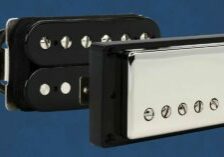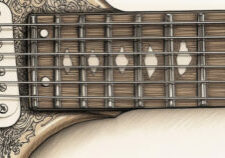Do you dream of strumming your favorite tunes on a guitar, but have been told that your fingers are too short? Fear not, for the truth about finger length and playing guitar may surprise you.
While it is true that long fingers can make certain techniques easier, they are not the end-all, be-all of playing this beloved instrument. Don’t forget, a lot of your favorite guitarists began when they were children. Besides, there are about as many styles of guitars and playing techniques as there are players’ hand types and the pros and cons of those types!
Proper technique is far more important than finger length when it comes to learning to play guitar. In fact, improper technique can lead to discomfort or even injury in your hands and wrists.
With the right guidance and practice, anyone can learn to play guitar regardless of their hand size or finger length.
So don’t let doubts about your physical attributes hold you back from pursuing your musical passions – read on for tips on how to overcome any challenges you may face along the way.
Key Takeaways
- Proper technique is more important than having long fingers for guitar playing.
- Hand posture, flexibility, and finger strength are crucial for proper technique.
- Choosing the right guitar depends on musical preferences and playing style, and testing out guitars before purchasing is essential.
- Regular practice and finger strengthening are crucial for improvement, and seeking guidance and resources can also help improve skills and knowledge.
The Importance of Proper Technique
Proper technique is crucial when playing guitar, so don’t skip out on practicing those finger placements. Finger placement is one of the most important aspects of guitar playing as it determines the sound and quality of your music.
Make sure that you place your fingers on the frets accurately, with each finger pressing down firmly on the string to produce a clear sound. This might take some time and patience, but eventually, your muscle memory will kick in and you’ll be able to do it without even thinking.
Hand posture also plays an essential role in proper technique. It’s important to keep your hand relaxed and at a comfortable angle while holding the guitar. Don’t grip too tightly or arch your wrist too much as this can cause unnecessary strain and tension in your hands, leading to cramps or injuries over time. Instead, try to maintain a natural position with your thumb behind the neck of the guitar for support.
Incorporating these techniques into your practice routine will not only improve your overall performance but also prevent any potential injuries from happening down the line. Remember that learning how to play guitar takes time and dedication, so don’t get discouraged if progress seems slow at first. With consistent practice and attention to proper technique, you’ll soon be able to play with ease and confidence.
The Role of Hand Size
Hand size can impact one’s ability to easily reach certain chords and frets on the guitar. However, it is not necessary to have long fingers in order to play the instrument. What is more important is hand flexibility and finger strength.
A common misconception among beginners is that they need to have long fingers in order to play guitar successfully. Sure, long fingers make it easier to reach for notes with wider stretches, but it does not necessarily determine one’s ability to play well. In fact, there are many successful guitar players who do NOT have large hands or long fingers. (Think Angus Young or Paul Simon, even Prince – these iconic gents aren’t much taller than 5 feet and their hands fit their physical stature.)
Hand flexibility plays a crucial role in being able to move smoothly between chords and frets. Practicing stretching exercises before playing can help improve flexibility over time. Additionally, building finger strength through consistent practice will allow for greater control over the strings and better execution of techniques such as bending or vibrato. Overall, while hand size may be a factor in playing guitar, it should not deter anyone from pursuing their passion for music.
Choosing the Right Guitar
When it comes to choosing the right guitar, there are several key points to consider. Firstly, you’ll need to decide which type of guitar is best suited for your musical preferences and playing style.
Secondly, the neck width and scale length will play a crucial role in determining how comfortable and easy it is for you to play.
Finally, testing out guitars before making a purchase is essential to ensure that you choose one that feels and sounds right for you. Don’t rush this decision – take your time and make an informed choice based on these factors!
Different Types of Guitars
Whether you’re strumming on a classic acoustic or shredding on an electric, the type of guitar you choose can greatly impact the sound and style of your playing. There are several different types of guitars to choose from, each with its unique characteristics that cater to specific genres and playing styles. These include acoustic, electric, classical, flamenco, and many more.
Acoustic guitars come in two main types: nylon-stringed and steel-stringed. Nylon-stringed guitars have a mellow and warm sound commonly associated with classical music while steel-stringed ones have a brighter tone suited for rock or country music. Classical and Flamenco guitars are variations of acoustic guitars that use nylon strings. Flamenco guitar just have a thinner top and less bracing.
Electric guitars, on the other hand, produce their sound by converting string vibrations into electrical signals that pass through an amplifier before reaching the speakers. This allows for greater versatility in terms of tone shaping and effects processing compared to their acoustic counterparts.
Neck Width and Curvature
To get the perfect fit for your playing style, it’s important to consider the neck width and scale length of the guitar you’re interested in.
Wide and flat necks can be great for playing individual notes and really complex chords as the strings are at a similar height. Flat necks are also really good for play rhythm guitar and heavy metal and can be easier for shredding. They are also a bit better if you suffer from arthritic hands.
Narrow and round necks make it easier to play barre chords or power chords. The curve in the neck with a properly set bridge requires less pressure to accurately fret the string. If you tend to play a lot of blues or leads with big 1-2 step bends, then the curved radius makes it much easier.
I have a variety of necks and will play certain songs with different guitars. And these are just general rules, but there as reason you see a lot of blues player using a Fender strat with a curved radius.
Scale Length
Scale length refers to the length of the vibrating portion of the strings on a guitar, from the nut to the bridge. Different guitars have varying scale lengths, which can affect the instrument’s playability, tone, and overall feel. Here are some pros and cons of different scale lengths for guitars:
Short Scale Lengths:
Pros:
– Easier to play: Shorter scale lengths typically require less finger stretching, making them ideal for players with smaller hands or beginners.
– Reduced string tension: Shorter scales often result in lower string tension, which can make bending notes and playing techniques like vibrato easier.
– Enhanced warm and mellow tone: Shorter scales tend to produce a warmer and mellower tone due to the decreased string tension.
Cons:
– Less sustain: Shorter scale lengths may sacrifice sustain compared to longer scales, as the strings have less length to vibrate.
– Reduced resonance and depth: The warm and mellow tone can sometimes lack the depth and resonance that longer scales provide.
Standard Scale Lengths:
Pros:
– Versatility: Standard scale lengths, usually ranging from 24.75″ to 25.5″, are widely used across different guitar styles and genres, offering a familiar feel for most players.
– Balanced tone: Standard scale lengths often provide a balanced tone with a good mix of warmth and brightness.
– Increased sustain: Longer scales tend to enhance sustain, allowing notes to ring out for longer durations.
Cons:
– Requires more finger stretching: Longer scale lengths may pose challenges for players with smaller hands or those transitioning from shorter scale guitars.
– Higher string tension: Longer scales generally result in higher string tension, which can make bending notes and playing techniques like vibrato more physically demanding.
3. Extended Scale Lengths:
Pros:
– Improved string tension and clarity: Extended scale lengths, typically over 25.5″, offer higher string tension, resulting in improved clarity, articulation, and note definition.
– Enhanced low-end response: Longer scales can provide greater low-end response and tightness, making them particularly suitable for players who enjoy heavier genres like metal or drop-tuned playing.
– Increased resonance and sustain: Extended scale lengths often enhance resonance and sustain, allowing notes to ring out with more richness and duration.
Cons:
– Challenging for smaller hands: Extended scale lengths may prove difficult for players with smaller hands, as they require greater finger stretching.
– Potential for increased string tension fatigue: The higher string tension on extended scale guitars can cause more fatigue and discomfort during prolonged playing sessions.
These pros and cons are not definitive, as personal preference and playing style play a significant role in determining the ideal scale length for individual guitarists. For example, I have several Fender strats and even with higher string tension, I don’t find them harder to play than my other guitars.
The Benefits of Practicing
Practicing regularly can lead to significant improvements in your guitar playing. Studies show that even as little as 30 minutes a day can make a noticeable difference.
One of the key benefits of practicing is finger strengthening, which is crucial for guitar players. As you practice, your fingers will become more agile and dexterous, allowing you to move between chords and notes with greater ease.
Another benefit of practicing is muscle memory. When you practice something repeatedly, your muscles begin to remember how it’s done and eventually perform the action without conscious effort. This is particularly important for guitarists who need to move their fingers quickly and accurately across the fretboard.
By practicing regularly, you’ll develop muscle memory that will help you play better and faster.
Finally, practicing regularly can also help improve your overall technique. As you practice different exercises and songs, you’ll learn new techniques that will enhance your playing ability. Additionally, regular practice helps build confidence in your playing skills which leads to improved musicianship on stage or during performances.
So don’t underestimate the importance of consistent practice – it may be the key to unlocking your full potential as a guitarist!
Seeking Professional Guidance
Looking to take your guitar playing to the next level? Consider seeking out professional guidance to improve your skills and expand your musical knowledge.
Even though there are some amazing guitar teachers online, I still advise new players to take in-person lessons. This allows an expert to really watch your technique and hand placement. Finding a skilled instructor who can guide you through the techniques, nuances, and subtleties of guitar playing is one of the most effective ways to elevate your performance.
Let’s Sum This Up
Believe it or not, with the right attitude and guidance, becoming a skilled guitarist is within reach for anyone. It’s true that some people may have certain physical advantages when it comes to playing guitar, such as long fingers or strong hands. However, that doesn’t mean those without these attributes can’t excel at the instrument.
So do you need long fingers to play guitar? The answer is definitely, no.
Overcoming obstacles is part of the journey towards becoming a great guitarist. Whether it’s struggling with chord changes or feeling self-conscious about your playing abilities, these challenges can be overcome with practice and persistence. Don’t let setbacks discourage you – keep pushing yourself to improve and seek out resources like online tutorials or lessons from a professional instructor to help guide you along the way.
Building confidence is another key component in learning how to play guitar successfully. Remember that everyone starts somewhere and nobody becomes an expert overnight. Celebrate small victories along the way, whether it’s finally nailing a difficult riff or performing in front of others for the first time. With dedication and hard work, you’ll be amazed at how far you can go on your guitar-playing journey.
So, don’t let the size of your hands discourage you from playing guitar. Your passion for music will drive you forward as you learn new techniques and gain confidence in your abilities.





